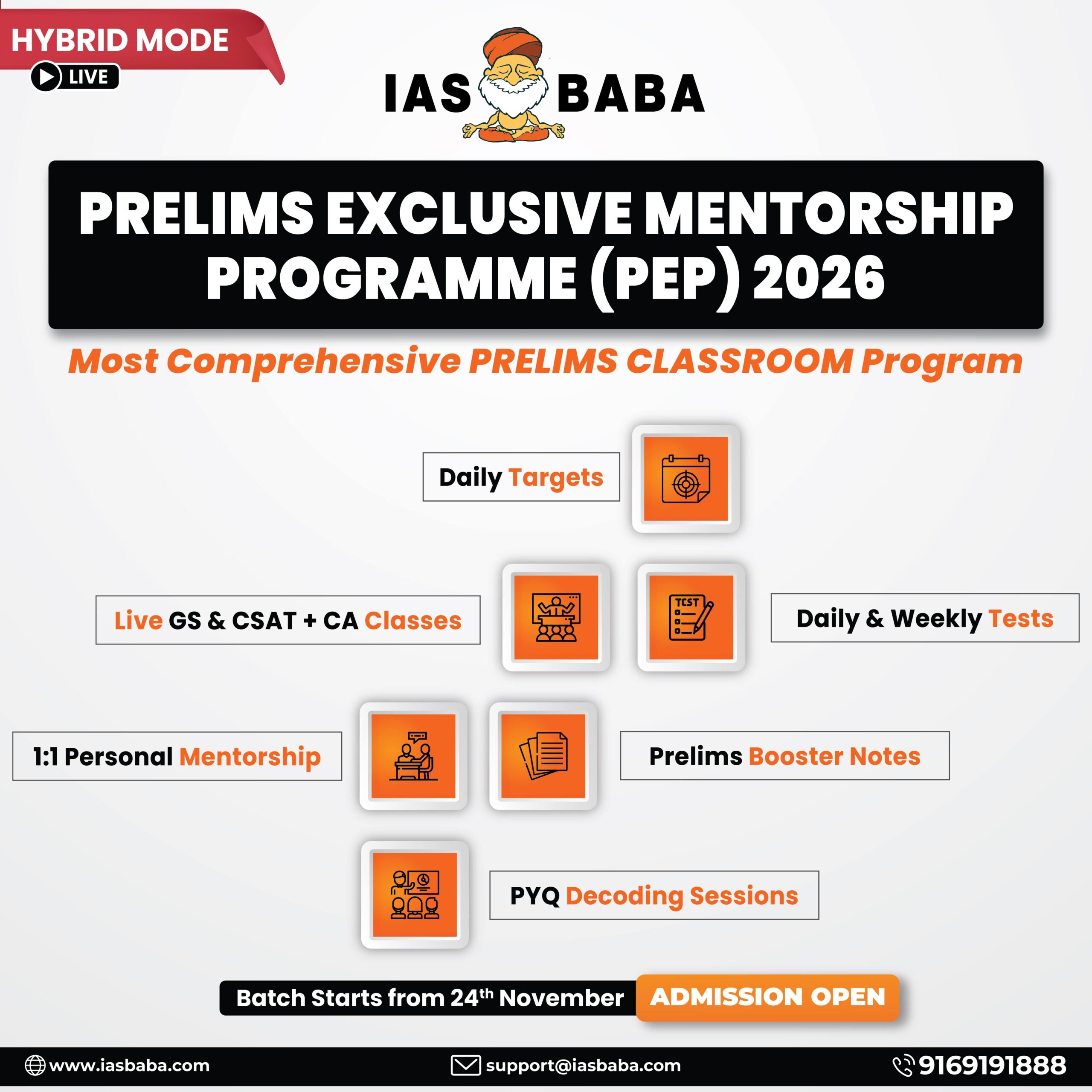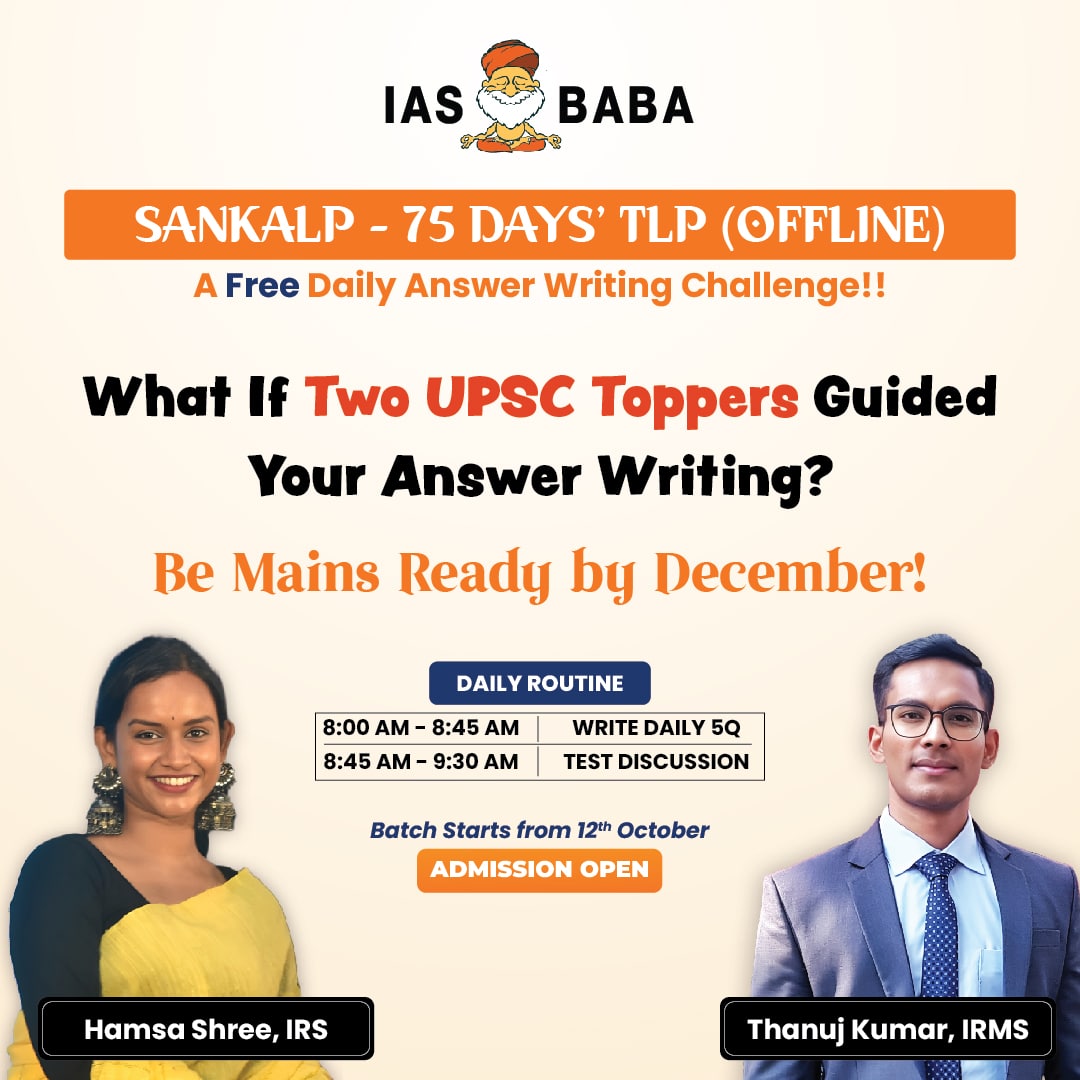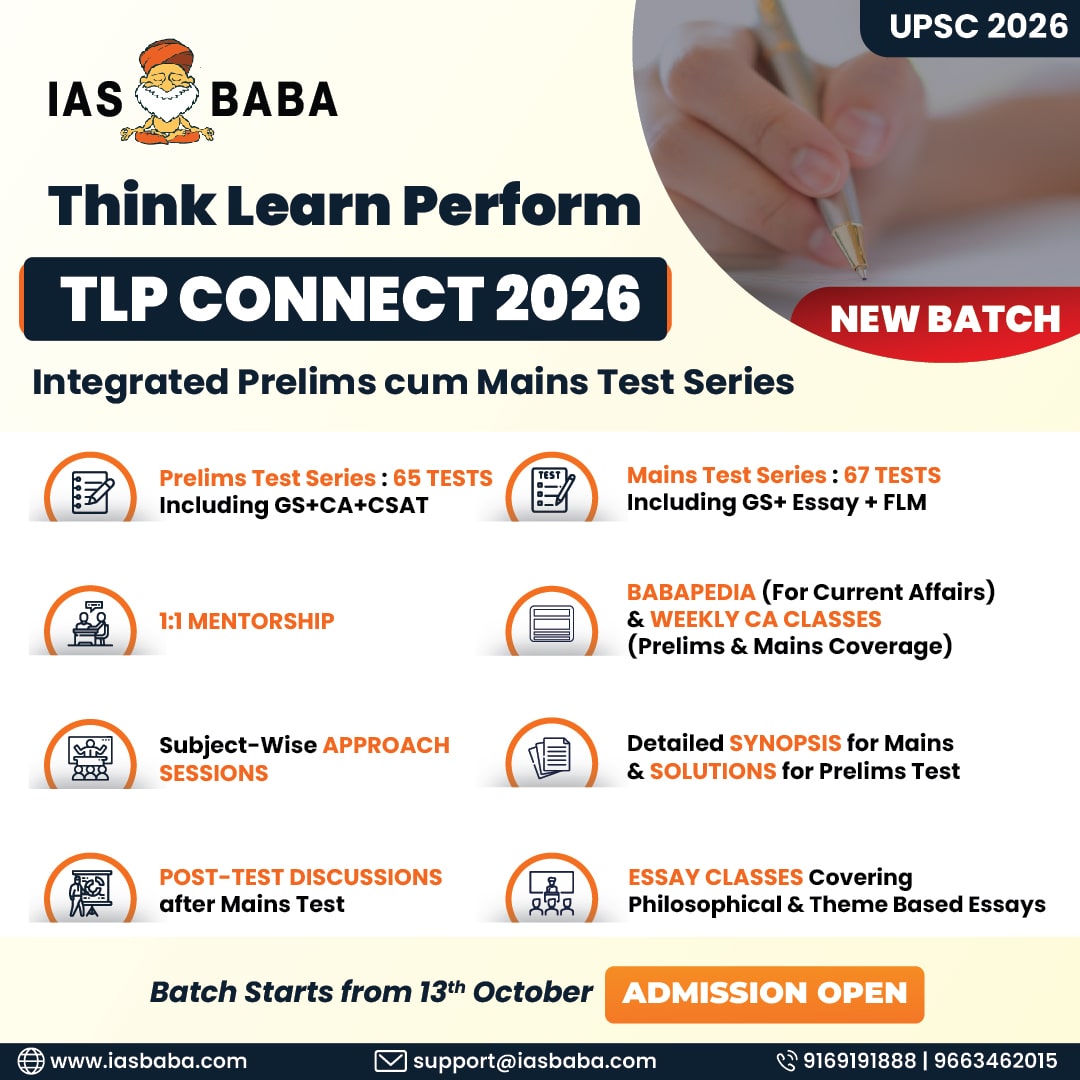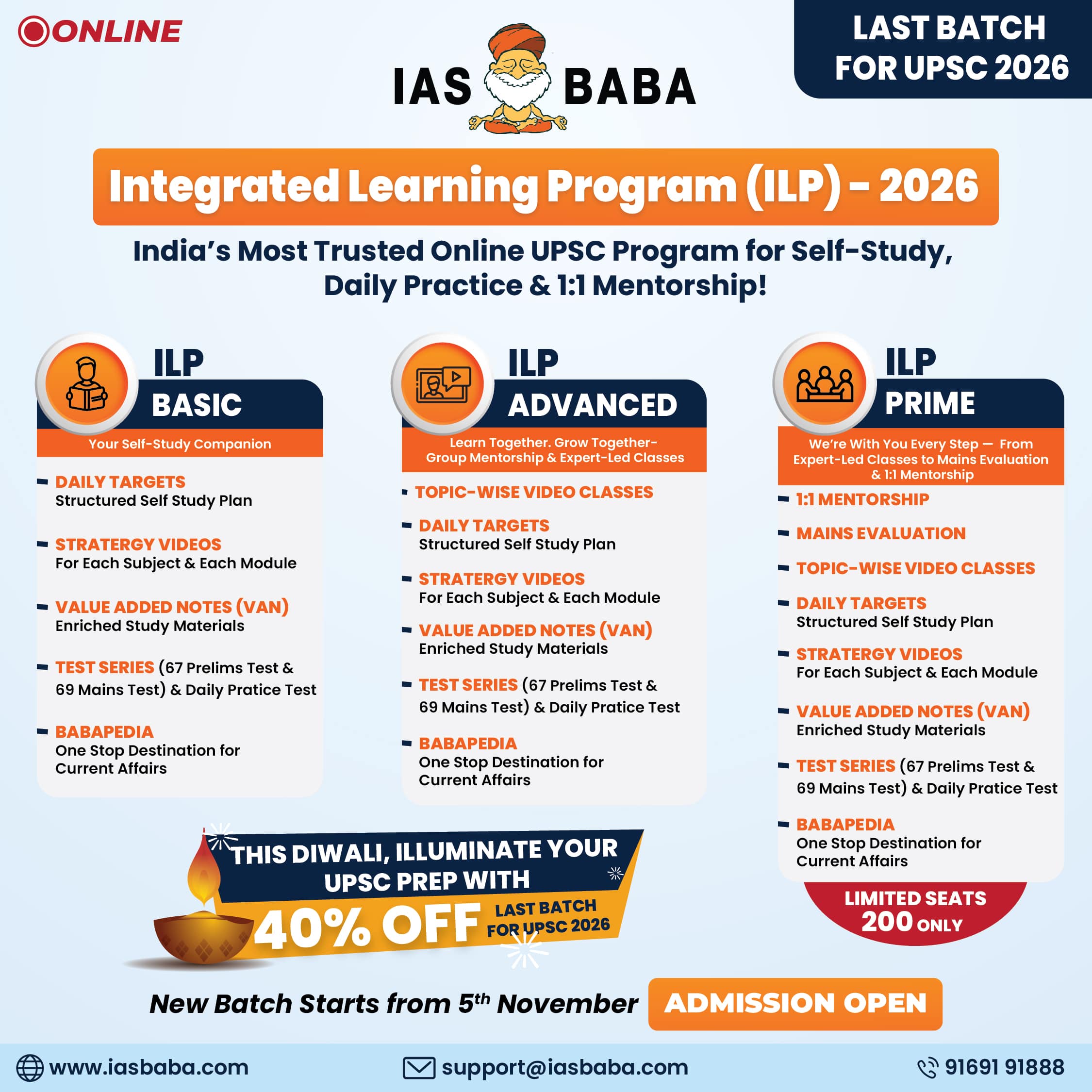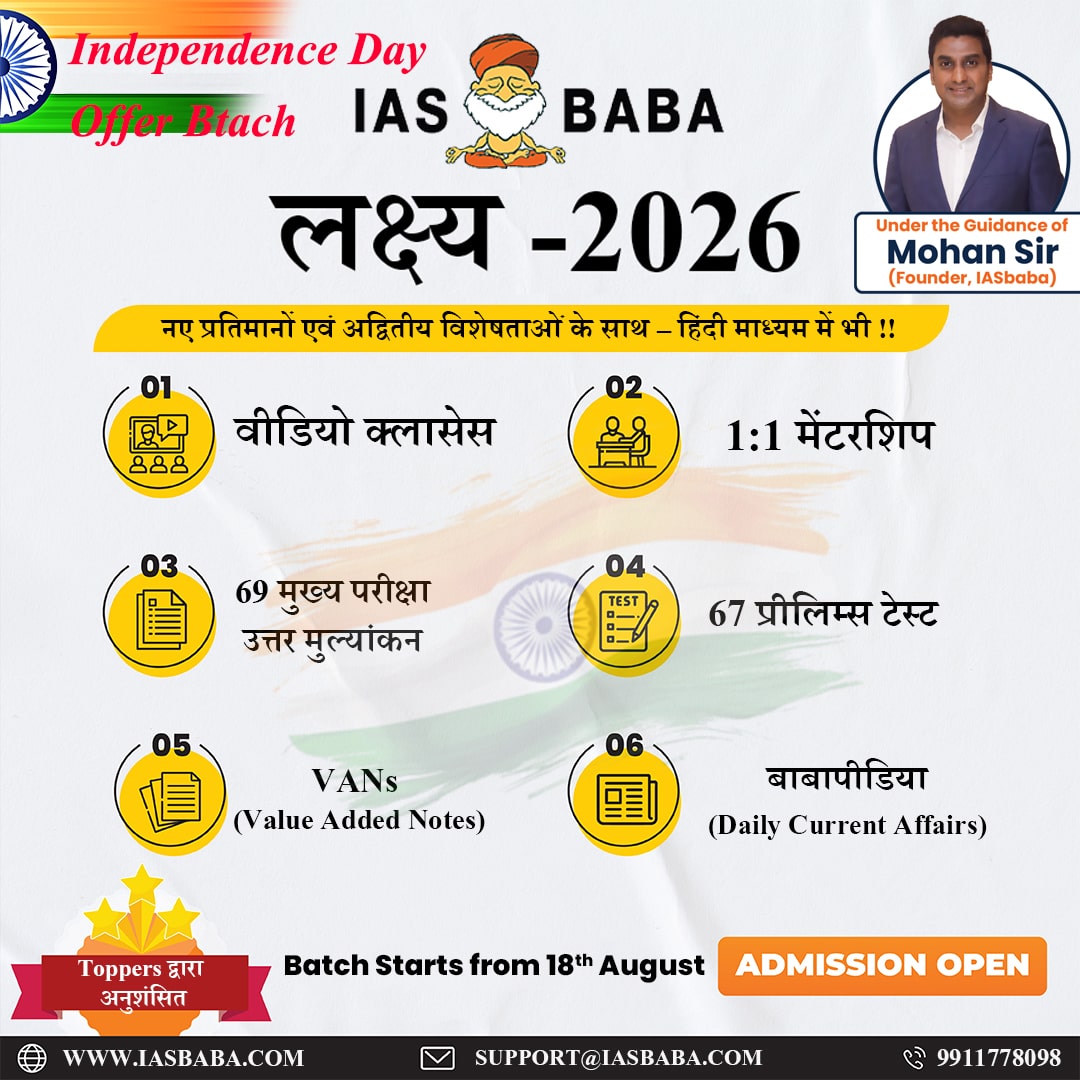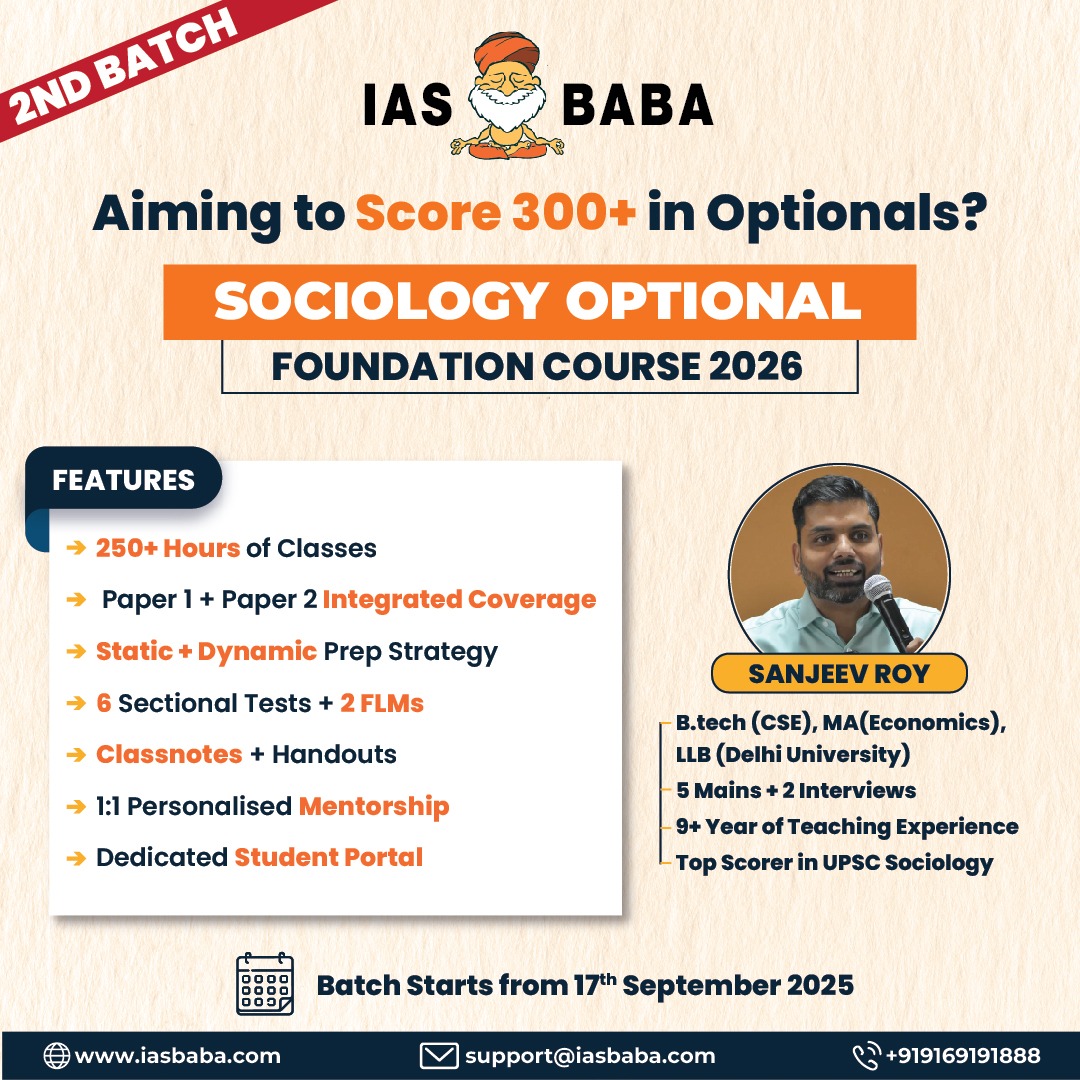IASbaba's Daily Current Affairs Analysis
Archives
(PRELIMS Focus)
Category: POLITY
Context: India has transformed its food safety system from adulteration control to a science-based, consumer-focused framework under the FSSAI, established by the 2006 Act.
Decoding Context:
Key Reforms
- Risk-Based Regulation: Standards now align with global benchmarks, with defined limits for residues and additives.
- Scientific Strengthening: India is conducting Total Diet Studies to reflect local diets and exposures.
- Global Harmonization: Regulations increasingly match international norms.
Institutional Initiatives
- Digital Oversight: Platforms like FoSCoS manage licensing and compliance.
- Training & Certification: Programs like FoSTaC enhance industry standards.
- Public Campaigns: Initiatives like Eat Right India and SNF promote healthy diets.
- Sustainability Focus: Jaivik Bharat, RUCO, and food waste reduction tackle broader health and environmental goals.
Challenges
- Data Gaps: Need for India-specific studies.
- Poor Risk Communication: Technical language limits public understanding.
- Trust Deficit: More transparency and engagement needed.
Learning Corner:
Brief Note on Food Safety Initiatives by FSSAI
The Food Safety and Standards Authority of India (FSSAI) is the apex body responsible for regulating and supervising food safety in India. It adopts a multi-dimensional approach to ensure the availability of safe and nutritious food through the following key initiatives:
- Eat Right India Movement
A flagship initiative aimed at transforming the country’s food system. It promotes:
- Safe, healthy, and sustainable food
- Reduction in salt, sugar, and trans fats
- Awareness on food labeling and fortification
- FoSTaC (Food Safety Training and Certification)
- Provides structured training to food handlers and supervisors across the food value chain
- Mandatory for licensed food businesses to have at least one certified supervisor
- FoSCoS (Food Safety Compliance System)
- A digital platform for licensing, registration, and compliance monitoring of food businesses
- Replaced the earlier FLRS (Food Licensing and Registration System)
- RUCO (Repurpose Used Cooking Oil)
- Promotes safe disposal and repurposing of used cooking oil into biodiesel
- Addresses health and environmental hazards of reusing oil
- Jaivik Bharat
- Certifies and promotes organic food products
- Helps consumers identify authentic organic food through the Jaivik Bharat logo
- Clean Street Food Hub and Eat Right Campus
- Targets hygiene and safety improvements in specific environments:
- Street Food Hubs: Upgrades clusters of street food vendors
- Campuses: Encourages institutions to serve safe and healthy food
- Safe and Nutritious Food (SNF) Campaign
- Spreads food safety awareness in homes, schools, and workplaces
- Encourages safe food practices and dietary diversity
- Save Food, Share Food
- Focuses on minimizing food wastage
- Encourages redistribution of excess food to those in need
Source : THE HINDU
Category: SCIENCE AND TECHNOLOGY
Context The launch, initially scheduled for June 10, 2025, was postponed due to poor weather. The revised launch time is June 11 at 8:00 a.m. EDT (5:30 p.m. IST).
Decoding Context:
Axiom Mission 4 (Ax-4): Overview
Axiom Mission 4 (Ax-4) is a private astronaut mission to the International Space Station (ISS), organized by Axiom Space in collaboration with NASA and SpaceX. The mission will launch aboard a SpaceX Falcon 9 rocket from Kennedy Space Center, Florida.
Crew Composition
- Commander: Peggy Whitson (former NASA astronaut)
- Pilot: Shubhanshu Shukla (India, ISRO)
- Mission Specialists: Sławosz Uznański-Wiśniewski (Poland, ESA) and Tibor Kapu (Hungary)
This marks the first ISS mission involving astronauts from India, Poland, and Hungary, and their return to government-sponsored spaceflight after four decades.
Mission Goals
- Duration: ~14 days
- Over 60 experiments in areas like human research, biology, materials science, and Earth observation
- Promotes international cooperation and advances microgravity research
Viewing Options
- Live coverage of the launch, docking, and ISS arrival will be available via NASA, SpaceX, and Axiom Space platforms.
- Docking is expected at 12:30 p.m. EDT (10:00 p.m. IST) on June 11.
Source: THE HINDU
Category: INTERNATIONAL
Context The significance of drones have increased during Russia-Ukraine war
Decoding Context:
- Decisive Role: By 2025, drones are responsible for 60–70% of damage to Russian military equipment, becoming a dominant tool in battlefield operations.
- Mass Production: Ukraine produces around 200,000 First Person View (FPV) drones monthly. These affordable ($200–$400) drones are highly effective against costly Russian tanks and systems.
- Advanced Capabilities: Ukrainian drones now serve multiple roles—bombing, reconnaissance, relay, and AI-enabled targeting—demonstrating high adaptability.
- Strategic Innovation: Ukraine’s GOGOL-M “mothership” drone can autonomously deploy two FPV drones over 300 km, targeting critical assets deep in Russian territory.
- Russian Response: Russia has developed drones like the Tyuvik (resistant to jamming) and fiber-optic models, though they face issues with AI autonomy, as seen in Lancet-3 glitches.
- Drone Boats: Ukraine introduced armed naval drones like the Magura V7, reportedly used to shoot down Russian aircraft—an unprecedented feat in maritime drone warfare.
- Tactical Evolution: Ukraine employs “drone walls” along front lines to disrupt enemy troops and conducts long-range strikes against airfields and military hubs.
- Global Impact: The Ukraine conflict has reshaped global military doctrine, with countries like Taiwan, Israel, and NATO members now prioritizing drone and counter-drone strategies.
Learning Corner:
- First Person View (FPV) Drones – Ukraine
- Type: Low-cost, manually piloted attack drones.
- Cost: Approx. $200–$400 per unit.
- Roles:
- Reconnaissance
- Precision strike (kamikaze mode)
- Intelligence, Surveillance, and Reconnaissance (ISR)
- Relay and jamming missions
- AI-enabled variants under development
- Impact: Account for 60–70% of the damage to Russian assets by early 2025.
- Significance: Mass-produced (approx. 200,000/month); extremely effective against high-value Russian targets like tanks.
- GOGOL-M “Mothership” Drone – Ukraine
- Type: Advanced autonomous drone platform.
- Capabilities:
- Can carry and launch two FPV drones
- Autonomous target identification, tracking, and strike
- Range: Up to 300 km
- Targets: Deep strike against aircraft, fuel depots, infrastructure
- Innovation: Combines AI with long-range precision warfare; still undergoing battlefield testing.
- Magura V7 Naval Drone – Ukraine
- Type: Unmanned surface vessel (USV).
- Unique Feature: Reportedly the first naval drone to shoot down a fighter jet using surface-to-air missiles.
- Capabilities:
- Autonomous navigation
- Carries missile payloads
- Long-range maritime operations
- Impact: Expands drone warfare to sea-to-air combat, a new domain in drone deployment.
- Tyuvik Light Attack Drone – Russia
- Type: Compact attack drone.
- Key Features:
- Autopilot and target-homing system
- Designed to withstand electronic warfare (EW)
- High maneuverability in contested zones
- Use Case: Deployed as an answer to Ukraine’s FPV threat.
- Fiber-Optic Drones – Russia
- Type: Tethered or wired drones.
- Capabilities:
- Less vulnerable to jamming or signal interference
- Reliable in dense EW environments
- Application: Increasingly used in areas where radio signals are disrupted.
- Lancet-3 Kamikaze Drone – Russia
- Type: Loitering munition.
- Function:
- Autonomous targeting of enemy equipment
- Dive-attack strike
- Challenges:
- Reported issues with AI-based targeting
- Occasional malfunctions in high-intensity EW zones
Summary Table
| Drone | Country | Type | Notable Features | Role |
|---|---|---|---|---|
| FPV Drones | Ukraine | Multirole | Cheap, mass-produced, high damage potential | ISR, attack, jamming |
| GOGOL-M | Ukraine | Mothership | AI-enabled, launches 2 FPVs up to 300 km | Long-range strike |
| Magura V7 | Ukraine | Naval | Missile-capable USV, downed jet | Naval + airstrike hybrid |
| Tyuvik | Russia | Light attack | EW-resistant, autopilot, target homing | Frontline attack |
| Fiber-optic drones | Russia | Recon/Attack | Signal-proof due to wired control | EW zones, stable operations |
| Lancet-3 | Russia | Loitering | Autonomous, sometimes glitchy | Precision strike |
Source : THE HINDU
Category: ECONOMICS
Context : Impact of China’s Rare Earth Export Ban: Suzuki Suspends Swift Production
Decoding Context
China’s rare earth mineral export ban has disrupted global supply chains, prompting Suzuki to halt production of its Swift hatchback in Japan—the first such move by a Japanese automaker due to this issue.
Key Highlights:
- Production Halt: Suzuki suspended Swift production (excluding Swift Sport) at its Sagara plant from May 26 to June 6, 2025, due to parts shortages.
- Root Cause: China’s April 2025 export curbs on rare earths and related magnets affected key components like motors and sensors, which are essential for automotive manufacturing.
- Wider Impact: Other automakers and European suppliers are also facing disruptions. Companies like Mercedes-Benz are seeking to diversify supply chains.
- Geopolitical Angle: The ban is seen as retaliation against US tariffs and has implications beyond the auto sector, affecting aerospace, defense, and electronics industries.
- Recovery Plan: Suzuki aims to resume partial production on June 13 and fully by June 16 as supplies stabilize.
Learning Corner:
some of the key rare earth metals (REMs), grouped as Light and Heavy rare earths:
Light Rare Earth Elements (LREEs):
- Lanthanum (La) – Used in camera lenses, battery electrodes
- Cerium (Ce) – Used in polishing agents, catalytic converters
- Praseodymium (Pr) – Used in magnets, aircraft engines
- Neodymium (Nd) – Vital for high-strength permanent magnets (used in EV motors, wind turbines)
- Promethium (Pm) – Radioactive; used in nuclear batteries
- Samarium (Sm) – Used in magnets and nuclear reactors
- Europium (Eu) – Used in phosphors for TV and LED screens
Heavy Rare Earth Elements (HREEs):
- Gadolinium (Gd) – MRI contrast agents, nuclear reactors
- Terbium (Tb) – Used in green phosphors, solid-state devices
- Dysprosium (Dy) – Added to magnets to improve performance at high temperatures
- Holmium (Ho) – Strongest magnetic field among elements; used in magnets
- Erbium (Er) – Used in fiber-optic communication, lasers
- Thulium (Tm) – Portable X-ray devices
- Ytterbium (Yb) – Used in stress gauges, certain lasers
- Lutetium (Lu) – Used in PET scan detectors, catalysts
- Scandium (Sc) – Lightweight alloys in aerospace
- Yttrium (Y) – Used in superconductors, LEDs, and ceramics
Source: THE INDIAN EXPRESS
Category: POLITY
Context : Opposition leaders, particularly Rahul Gandhi, regarding the conduct of elections after the 2024 Maharashtra Assembly polls.
Decoding Context:
Key issues include unexplained spikes in voter rolls, unusually high voter turnout post-5 p.m., and limited access to CCTV footage of polling stations.
While past data shows similar trends in voter roll expansion, the Election Commission of India (ECI) is urged to verify new additions thoroughly. The claim of post-5 p.m. turnout anomalies has been countered by official data, yet transparency remains a pressing issue.
Learning Corner:
Election Commission of India (ECI) – Brief Overview
Mandate & Structure
- The Election Commission of India is a constitutional body under Article 324 of the Constitution.
- It is responsible for administering elections to the Lok Sabha, State Legislative Assemblies, and the offices of the President and Vice President.
- The Commission consists of the Chief Election Commissioner (CEC) and two Election Commissioners.
Functions
- Supervise, direct, and control the entire process of elections.
- Prepare and revise electoral rolls.
- Monitor election campaigns and enforce the Model Code of Conduct.
- Regulate political parties and ensure transparent use of EVMs and VVPATs.
- Decide matters related to disqualification of members and recognition of political parties.
Tenure & Independence
- The CEC and Election Commissioners hold office for 6 years or until the age of 65 years, whichever is earlier.
- The CEC can only be removed through a process similar to that of a Supreme Court judge, ensuring independence.
Recent Changes in Appointment Process
Supreme Court Interim Directive (March 2023)
- Mandated that the appointment of the CEC and ECs be recommended by a Collegium consisting of the Prime Minister, Leader of Opposition (Lok Sabha), and the Chief Justice of India, to ensure neutrality and transparency.
Chief Election Commissioner and Other ECs (Appointment, Conditions of Service and Term of Office) Act, 2023
- Replaced the Supreme Court’s interim arrangement with a new appointment process.
- A Search Committee led by the Law Minister shortlists candidates.
- A Selection Committee, headed by the Prime Minister and including the Leader of Opposition and a Cabinet Minister, recommends names to the President.
- The role of the Chief Justice of India was excluded from the selection panel.
Additional Provisions in the 2023 Law
- Salary and service conditions of the CEC and ECs are now equivalent to that of the Cabinet Secretary.
- The Act restricts CEC and ECs to a single term, with no reappointment.
Concerns & Criticism
- The exclusion of the judiciary from the selection process has raised concerns over executive dominance.
- Legal challenges are ongoing regarding the constitutional validity of the 2023 law.
- Critics argue the changes may weaken the independence and credibility of the ECI.
Comparison table – Evolution of appointment of election commissioners in India
| Aspect | Before March 2023 | Post-March 2023 Ruling | After 2023 Act |
|---|---|---|---|
| Appointment Body | Sole Executive discretion | Interim Collegium (PM, LoP, CJI)) | Search & Selection committees (PM, LoP, Cabinet Minister) |
| CJI’s Role | NIL | Appointing authority within Collegium | Excluded from Selection Committee |
| Safeguards | No institutional checks | SC transparency measure pending formal law | Executive-heavy structure; executive influence reintroduced |
| Legal Status | Largely Executive decision-making | Court-mandated till a law was passed | Legal, but judicial verdicts pending review |
Source : THE HINDU
(MAINS Focus)
Date: 10-06-2025 |
Mainspedia |
|
TOPIC: Axiom -4 Mission |
GS Paper III – Science and Technology |
|
Introduction (Context)National Aeronautics and Space Administration (NASA), as part of its collaborative efforts with the Indian Space Research Organisation (ISRO), is set to launch Axiom Mission 4. This will be the fourth private astronaut flight from Axiom Space and the first to carry an Indian astronaut to the International Space Station (ISS). The four-member crew also has astronauts from Poland and Hungary – countries that, like India, are sending their nationals to space after 40 years — underlining the very diverse nature of participation in this mission. |
||
Background |
|
|
About Axiom 4 mission |
|
|
Mission specific to ISRO |
1. Biological Experiments:
2. Technological Experiments:
|
|
Significance for India |
|
|
Value addition |
About Artemis Accords
About Shubhanshu Shukla
About Tardigrades
Known for extreme resilience:
Mechanism of Survival:
|
|
ConclusionThe Axiom-4 mission featuring Shubhanshu Shukla marks a pivotal moment in India’s space journey. This mission provides tangible knowledge, operational experience, and global visibility. It strengthens the pipeline to Gaganyaan, Moon missions, and beyond, positioning India as a serious contender in the new space age — scientifically, strategically, and economically. |
||
Mains Practice Question
Q Critically examine the significance of the Axiom-4 mission for India’s space programme and its broader implications for space diplomacy and the space economy. (250 words, 15 marks)
| Date: 10-06-2025 | Mainspedia | |
TOPIC: Declining Poverty in India: Trends, Data and Policy Implications |
GS Paper III – Economy |
|
Introduction (Context)
|
||
| What is Poverty? |
|
|
Types of Poverty |
|
|
What is Extreme Poverty? |
|
|
How is Poverty Calculated? |
Household Consumption Expenditure Surveys (HCES) by NSSO/NSO
Multidimensional Poverty Index (MPI)
Gini and Theil Indices – Measures of Inequality
|
|
Key trends and data |
|
|
Value addition |
Government schemes for Poverty alleviation
MGNREGS (Mahatma Gandhi National Rural Employment Guarantee Scheme)
Deen Dayal Antyodaya Yojana – National Rural Livelihoods Mission (DAY-NRLM)
PM-KISAN (Pradhan Mantri Kisan Samman Nidhi)
National Food Security Act (NFSA), 2013
POSHAN Abhiyaan (National Nutrition Mission)
PM Awas Yojana (PMAY)
Swachh Bharat Mission (SBM)
Ayushman Bharat – Pradhan Mantri Jan Arogya Yojana (PMJAY)
Samagra Shiksha Abhiyan
Deendayal Antyodaya Yojana – National Urban Livelihoods Mission (DAY-NULM)
One Nation One Ration Card (ONORC)
|
|
Way forward |
|
|
ConclusionThe sharp decline in extreme poverty in India is a positive socio-economic milestone, yet continued focus is needed on multidimensional poverty, urban vulnerability, and inclusive development. Data-backed policymaking, grounded in transparency and regularity, will be critical to sustaining and accelerating this progress. |
||
Mains Practice Question
Q Despite a sharp decline in extreme poverty levels, income and opportunity inequality persist in India. Examine the implications of this paradox for inclusive growth policies. (250 words, 15 marks)
Daily Practice MCQs
Today’s – Daily Practice MCQs’ will be updated in our “Daily Current Affairs Quiz” section on our website
Please click on the below link



